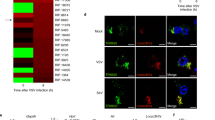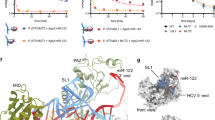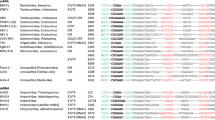Abstract
RNA interference through non-coding microRNAs (miRNAs) represents a vital component of the innate antiviral immune response in plants and invertebrate animals; however, a role for cellular miRNAs in the defence against viral infection in mammalian organisms has thus far remained elusive1. Here we show that interferon beta (IFNβ) rapidly modulates the expression of numerous cellular miRNAs, and that eight of these IFNβ-induced miRNAs have sequence-predicted targets within the hepatitis C virus (HCV) genomic RNA. The introduction of synthetic miRNA-mimics corresponding to these IFNβ-induced miRNAs reproduces the antiviral effects of IFNβ on HCV replication and infection, whereas neutralization of these antiviral miRNAs with anti-miRNAs reduces the antiviral effects of IFNβ against HCV. In addition, we demonstrate that IFNβ treatment leads to a significant reduction in the expression of the liver-specific miR-122, an miRNA that has been previously shown to be essential for HCV replication2. Therefore, our findings strongly support the notion that mammalian organisms too, through the interferon system, use cellular miRNAs to combat viral infections.
This is a preview of subscription content, access via your institution
Access options
Subscribe to this journal
Receive 51 print issues and online access
$199.00 per year
only $3.90 per issue
Buy this article
- Purchase on Springer Link
- Instant access to full article PDF
Prices may be subject to local taxes which are calculated during checkout




Similar content being viewed by others
References
Cullen, B. R. Is RNA interference involved in intrinsic antiviral immunity in mammals? Nature Immunol. 7, 563–567 (2006)
Jopling, C. L., Yi, M., Lancaster, A. M., Lemon, S. M. & Sarnow, P. Modulation of hepatitis C virus RNA abundance by a liver-specific microRNA. Science 309, 1577–1581 (2005)
Bartel, D. P. MicroRNAs: genomics, biogenesis, mechanism, and function. Cell 116, 281–297 (2004)
Ambros, V. The functions of animal microRNAs. Nature 431, 350–355 (2004)
Lewis, B. P., Burge, C. B. & Bartel, D. P. Conserved seed pairing, often flanked by adenosines, indicates that thousands of human genes are microRNA targets. Cell 120, 15–20 (2005)
Zamore, P. D. Plant RNAi: How a viral silencing suppressor inactivates siRNA. Curr. Biol. 14, R198–R200 (2004)
Baulcombe, D. RNA silencing in plants. Nature 431, 356–363 (2004)
Katze, M. G., He, Y. & Gale, M. Viruses and interferon: a fight for supremacy. Nature Rev. Immunol. 2, 675–687 (2002)
Samuel, C. E. Antiviral actions of interferons. Clin. Microbiol. Rev. 14, 778–809 (2001)
Liang, T. J., Rehermann, B., Seeff, L. B. & Hoofnagle, J. H. Pathogenesis, natural history, treatment, and prevention of hepatitis C. Ann. Intern. Med. 132, 296–305 (2000)
Lauer, G. M. & Walker, B. D. Hepatitis C virus infection. N. Engl. J. Med. 345, 41–52 (2001)
Wieland, S. F. & Chisari, F. V. Stealth and cunning: hepatitis B and hepatitis C viruses. J. Virol. 79, 9369–9380 (2005)
Rehermann, B. & Nascimbeni, M. Immunology of hepatitis B virus and hepatitis C virus infection. Nature Rev. Immunol. 5, 215–229 (2005)
Larner, A. C. et al. Transcriptional induction of two genes in human cells by beta interferon. Proc. Natl Acad. Sci. USA 81, 6733–6737 (1984)
Randall, G. et al. Cellular cofactors affecting hepatitis C virus infection and replication. Proc. Natl Acad. Sci. USA 104, 12884–12889 (2007)
Zhong, J. et al. Robust hepatitis C virus infection in vitro . Proc. Natl Acad. Sci. USA 102, 9294–9299 (2005)
Moradpour, D. et al. Insertion of green fluorescent protein into nonstructural protein 5A allows direct visualization of functional hepatitis C virus replication complexes. J. Virol. 78, 7400–7409 (2004)
Calin, G. A. & Croce, C. M. MicroRNA–cancer connection: the beginning of a new tale. Cancer Res. 66, 7390–7394 (2006)
Calin, G. A. & Croce, C. M. MicroRNA signatures in human cancers. Nature Rev. Cancer 6, 857–866 (2006)
O'Connell, R. M., Taganov, K. D., Boldin, M. P., Cheng, G. & Baltimore, D. MicroRNA-155 is induced during the macrophage inflammatory response. Proc. Natl Acad. Sci. USA 104, 1604–1609 (2007)
Kato, T. et al. Efficient replication of the genotype 2a hepatitis C virus subgenomic replicon. Gastroenterology 125, 1808–1817 (2003)
Cheng, G., Zhong, J. & Chisari, F. V. Inhibition of dsRNA-induced signaling in hepatitis C virus-infected cells by NS3 protease-dependent and -independent mechanisms. Proc. Natl Acad. Sci. USA 103, 8499–8504 (2006)
Liu, C. G. et al. An oligonucleotide microchip for genome-wide microRNA profiling in human and mouse tissues. Proc. Natl Acad. Sci. USA 101, 9740–9744 (2004)
Yanagi, M., Purcell, R. H., Emerson, S. U. & Bukh, J. Hepatitis C virus: an infectious molecular clone of a second major genotype (2a) and lack of viability of intertypic 1a and 2a chimeras. Virology 262, 250–263 (1999)
Wakita, T. et al. Production of infectious hepatitis C virus in tissue culture from a cloned viral genome. Nature Med. 11, 791–796 (2005)
Pietschmann, T. et al. Construction and characterization of infectious intragenotypic and intergenotypic hepatitis C virus chimeras. Proc. Natl Acad. Sci. USA 103, 7408–7413 (2006)
Zhong, J. et al. Robust hepatitis C virus infection in vitro . Proc. Natl Acad. Sci. USA 102, 9294–9299 (2005)
Acknowledgements
We thank G. Calin (OSU) for help with the microarray studies, D. Burton (TSRI) for E2-antibodies, and J. Zhong (TSRI) for many discussions. This work was supported by the NIH (I.M.P.), a private donation from C. Evans to F.V.C, and the NIH and UCSD Academic Senate Funding (M.D.).
Author Contributions G.C. and S.W. contributed equally to this work.
Author information
Authors and Affiliations
Corresponding author
Ethics declarations
Competing interests
The authors declare no competing financial interests.
Supplementary information
Supplementary Figures
The file contains Supplementary Figures 1 and 2 with Legends. (PDF 5004 kb)
Rights and permissions
About this article
Cite this article
Pedersen, I., Cheng, G., Wieland, S. et al. Interferon modulation of cellular microRNAs as an antiviral mechanism. Nature 449, 919–922 (2007). https://doi.org/10.1038/nature06205
Received:
Accepted:
Issue Date:
DOI: https://doi.org/10.1038/nature06205
This article is cited by
-
Circulating microRNAs as predictors of response to sofosbuvir + daclatasvir + ribavirin in in HCV genotype-4 Egyptian patients
BMC Gastroenterology (2022)
-
Exosomal miRNA-328-3p targets ZO-3 and inhibits porcine epidemic diarrhea virus proliferation
Archives of Virology (2022)
-
Involvement of host microRNAs in flavivirus-induced neuropathology: An update
Journal of Biosciences (2022)
-
Expression of plasma IFN signaling-related miRNAs during acute SARS-CoV-2 infection and its association with RBD-IgG antibody response
Virology Journal (2021)
-
Therapeutic potential of C1632 by inhibition of SARS-CoV-2 replication and viral-induced inflammation through upregulating let-7
Signal Transduction and Targeted Therapy (2021)
Comments
By submitting a comment you agree to abide by our Terms and Community Guidelines. If you find something abusive or that does not comply with our terms or guidelines please flag it as inappropriate.



